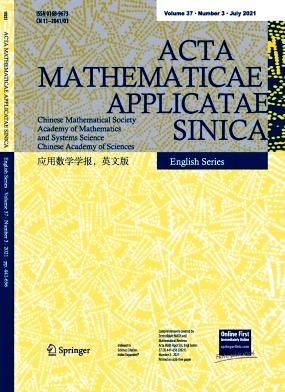论傅立叶空间中具有流体效应的趋化系统的初始层和极限行为
IF 0.9
4区 数学
Q3 MATHEMATICS, APPLIED
Acta Mathematicae Applicatae Sinica, English Series
Pub Date : 2024-11-06
DOI:10.1007/s10255-024-1134-3
引用次数: 0
摘要
本文讨论了具有流体效应的趋化系统的考奇问题。\cdot \nabla {u^\varepsilon }- \Delta {u^\varepsilon }+ \nabla {{rm{P}}^\varepsilon }= {n^\varepsilon }\nabla {c^\varepsilon },}\hfill & {{\rm{in}} }\fill & {{\mathbb{R}^d}\times \left( {0,\infty } \right),} \hfill \cr {\nabla \cdot {u^\varepsilon } = 0,} \hfill \cr {\nabla \cdot {u^\varepsilon } = 0,}= 0,} \hfill & {{\rm{in}}*times *left }\times \left( {0,\infty } \right),} \hfill \cr {n_t^\varepsilon + {u^\varepsilon }\cdot \nabla {n^\varepsilon }- \Delta {n^\varepsilon }= - \nabla \cdot \left( {{n^\varepsilon }\nabla {c^\varepsilon }} \right),} \hfill & {{{\rm{in}}}*fill & {{mathbb{R}^d}\times \left( {0,\infty } \right),} \hfill \cr {{1 \over \varepsilon }c_t^\varepsilon - \Delta {c^\varepsilon }= {n^\varepsilon },} \hfill & {{\rm{in}}}\fill & {{\mathbb{R}^d}\times \left( {0,\infty } \right),} \hfill \cr {\left( {{u^\varepsilon },{n^\varepsilon },{c^\varepsilon }} \right){|_{t = 0}} = \left( {{u_0},{n_0},{c_0}} \right),} \hfill & {{\rm{in}}\fill & {{\mathbb{R}^d},} \fill \cr }}\right.$$ 其中 d ≥ 2。众所周知,对于每个 ϵ >0和所有属于特定傅立叶空间的足够小的初始数据(u0, n0, c0),问题在傅立叶空间具有唯一的全局解(uϵ, nϵ, cϵ)。此外,我们还证明了 cϵ(t)在ϵ-1→0时具有初始层。本文章由计算机程序翻译,如有差异,请以英文原文为准。
On the Initial Layer and the Limit Behavior for Chemotaxis System with the Effect of Fluid in Fourier Space
The paper deals with a Cauchy problem for the chemotaxis system with the effect of fluid
$$\left\{ {\matrix{ {u_t^\varepsilon + {u^\varepsilon } \cdot \nabla {u^\varepsilon } - \Delta {u^\varepsilon } + \nabla {{\rm{P}}^\varepsilon } = {n^\varepsilon }\nabla {c^\varepsilon },} \hfill & {{\rm{in}}} \hfill & {{\mathbb{R}^d} \times \left( {0,\infty } \right),} \hfill \cr {\nabla \cdot {u^\varepsilon } = 0,} \hfill & {{\rm{in}}} \hfill & {{\mathbb{R}^d} \times \left( {0,\infty } \right),} \hfill \cr {n_t^\varepsilon + {u^\varepsilon } \cdot \nabla {n^\varepsilon } - \Delta {n^\varepsilon } = - \nabla \cdot \left( {{n^\varepsilon }\nabla {c^\varepsilon }} \right),} \hfill & {{\rm{in}}} \hfill & {{\mathbb{R}^d} \times \left( {0,\infty } \right),} \hfill \cr {{1 \over \varepsilon }c_t^\varepsilon - \Delta {c^\varepsilon } = {n^\varepsilon },} \hfill & {{\rm{in}}} \hfill & {{\mathbb{R}^d} \times \left( {0,\infty } \right),} \hfill \cr {\left( {{u^\varepsilon },{n^\varepsilon },{c^\varepsilon }} \right){|_{t = 0}} = \left( {{u_0},{n_0},{c_0}} \right),} \hfill & {{\rm{in}}} \hfill & {{\mathbb{R}^d},} \hfill \cr } } \right.$$
where d ≥ 2. It is known that for each ϵ > 0 and all sufficiently small initial data (u0, n0, c0) belongs to certain Fourier space, the problem possesses a unique global solution (uϵ, nϵ, cϵ) in Fourier space. The present work asserts that these solutions stabilize to (u∞, n∞, c∞) as ϵ−1 → 0. Moreover, we show that cϵ(t) has the initial layer as ϵ−1 → 0. As one expects its limit behavior maybe give a new viewlook to understand the system.
求助全文
通过发布文献求助,成功后即可免费获取论文全文。
去求助
来源期刊
CiteScore
1.30
自引率
0.00%
发文量
70
审稿时长
3.0 months
期刊介绍:
Acta Mathematicae Applicatae Sinica (English Series) is a quarterly journal established by the Chinese Mathematical Society. The journal publishes high quality research papers from all branches of applied mathematics, and particularly welcomes those from partial differential equations, computational mathematics, applied probability, mathematical finance, statistics, dynamical systems, optimization and management science.

 求助内容:
求助内容: 应助结果提醒方式:
应助结果提醒方式:


